
Xerox Holdings Corporation is an American corporation that sells print and digital document products and services in more than 160 countries. Xerox is headquartered in Norwalk, Connecticut, though it is incorporated in New York with its largest population of employees based around Rochester, New York, the area in which the company was founded. The company purchased Affiliated Computer Services for $6.4 billion in early 2010. As a large developed company, it is consistently placed in the list of Fortune 500 companies.
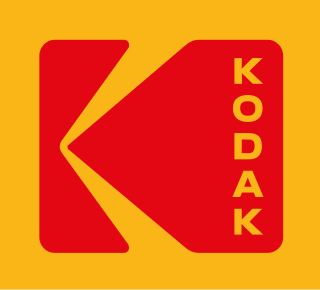
The Eastman Kodak Company, referred to simply as Kodak, is an American public company that produces various products related to its historic basis in film photography. The company is headquartered in Rochester, New York, and is incorporated in New Jersey. It is best known for photographic film products, which it brought to a mass market for the first time.
Duplicating machines were the predecessors of modern document-reproduction technology. They have now been replaced by digital duplicators, scanners, laser printers and photocopiers, but for many years they were the primary means of reproducing documents for limited-run distribution. The duplicator was pioneered by Thomas Edison and David Gestetner, with Gestetner dominating the market up until the late 1990s.
Rank Xerox Limited was formed in 1956 as a joint venture between the Xerox Corporation of United States and The Rank Organisation of the United Kingdom, to manufacture and market Xerox equipment initially in Europe and later in Africa and Asia. A further joint venture between Rank Xerox and Modi Group in India formed Modi Xerox to manufacture and sell Xerox equipment in the Indian subcontinent.

Fujifilm Holdings Corporation, trading as Fujifilm, or simply Fuji, is a Japanese multinational conglomerate headquartered in Tokyo, Japan, operating in the areas of photography, optics, office and medical electronics, biotechnology, and chemicals.
Xerox art is an art form that began in the 1960s. Prints are created by putting objects on the glass, or platen, of a photocopier and by pressing "start" to produce an image. If the object is not flat, or the cover does not totally cover the object, or the object is moved, the resulting image is distorted in some way. The curvature of the object, the amount of light that reaches the image surface, and the distance of the cover from the glass, all affect the final image. Often, with proper manipulation, rather ghostly images can be made. Basic techniques include: Direct Imaging, the copying of items placed on the platen ; Still Life Collage, a variation of direct imaging with items placed on the platen in a collage format focused on what is in the foreground/background; Overprinting, the technique of constructing layers of information, one over the previous, by printing onto the same sheet of paper more than once; Copy Overlay, a technique of working with or interfering in the color separation mechanism of a color copier; Colorizing, vary color density and hue by adjusting the exposure and color balance controls; Degeneration is a copy of a copy degrading the image as successive copies are made; Copy Motion, the creation of effects by moving an item or image on the platen during the scanning process. Each machine also creates different effects.
Chester Floyd Carlson was an American physicist, inventor, and patent attorney born in Seattle, Washington.

Xerography is a dry photocopying technique. Originally called electrophotography, it was renamed xerography—from the Greek roots ξηρόςxeros, meaning "dry" and -γραφία-graphia, meaning "writing"—to emphasize that unlike reproduction techniques then in use such as cyanotype, the process of xerography used no liquid chemicals.
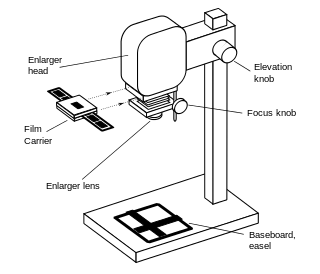
An enlarger is a specialized transparency projector used to produce photographic prints from film or glass negatives, or from transparencies.

The Gestetner is a type of duplicating machine named after its inventor, David Gestetner (1854–1939). During the 20th century, the term Gestetner was used as a verb—as in Gestetnering. The Gestetner company established its base in London, filing its first patent in 1879. The business grew, remaining within the control of the Gestetner family, and acquiring other businesses. In 1995, the Gestetner company was acquired by the Ricoh Corporation of Japan.
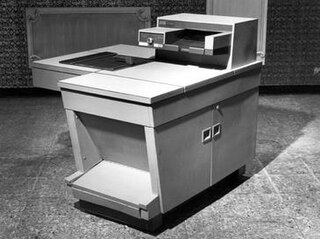
The Xerox 914 was the first successful commercial plain paper copier. Introduced in 1959 by the Haloid/Xerox company, it revolutionized the document-copying industry. The culmination of inventor Chester Carlson's work on the xerographic process, the 914 was fast and economical. The copier was introduced to the public on September 16, 1959, in a demonstration at the Sherry-Netherland Hotel in New York, shown on live television.

Ansco was the brand name of a photographic company based in Binghamton, New York, which produced photographic films, papers and cameras from the mid-19th century until the 1980s.
Canon Production Printing, known as Océ until the end of 2019, is a Netherlands-based subset of Canon that develops, manufactures and sells printing and copying hardware and related software. The product line includes office printing and copying machinery, production printers, and wide-format printers for both technical documentation and color display graphics.
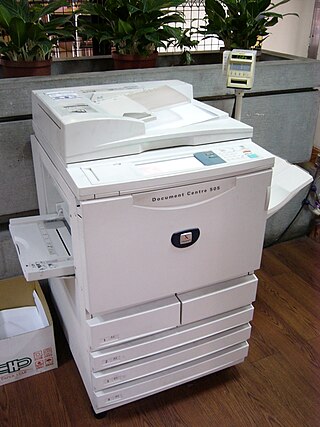
A photocopier is a machine that makes copies of documents and other visual images onto paper or plastic film quickly and cheaply. Most modern photocopiers use a technology called xerography, a dry process that uses electrostatic charges on a light-sensitive photoreceptor to first attract and then transfer toner particles onto paper in the form of an image. The toner is then fused onto the paper using heat, pressure, or a combination of both. Copiers can also use other technologies, such as inkjet, but xerography is standard for office copying.
Robert W. Gundlach was an American physicist. He is most noted for his prolific contributions to the field of xerography, specifically the development of the modern photocopier. Gundlach helped transform the Haloid Company, a small photographic firm, into the thriving Xerox Corporation. Over the course of his 42-year career with the company, he contributed over 155 patents, making photocopying technology more affordable and practical. In 1966 Gundlach was named Xerox's first Research Fellow, the highest non-managerial that could be achieved by a Xerox scientist. After his retirement in 1995, he was granted several patents associated with his hobbies, including a snow-making system and a special backpack.
Papert Koenig Lois, also known as PKL, was an advertising agency founded by Fred Papert, Julian Koenig and George Lois in January 1960. Its first office was in the Seagram Building in Park Avenue in Manhattan. Early clients included Peugeot and Xerox. Its campaigns were successful and it was the first such agency to go public.
John H. Dessauer, also known as Hans Dessauer, was a German-American chemical engineer and an innovator in developing xerography. He was instrumental in turning a $7 million company of the 1930s into Xerox, a billion-dollar copier company.
A contact copier is a device used to copy an image by illuminating a film negative with the image in direct contact with a photosensitive surface. The more common processes are negative, where clear areas in the original produce an opaque or hardened photosensitive surface, but positive processes are available. The light source is usually an actinic bulb internal or external to the device
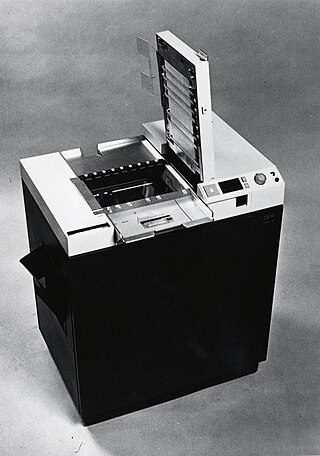
IBM Office Products Division (OPD) manufactured and sold copier equipment and supplies from 1970 till IBM withdrew from the copier market in 1988. IBM's decision to compete in this market resulted in the first commercial use of an organic photoconductor now widely used in most photocopiers. It is often held up as an example of a corporate u-turn, where a company rejects a technology and then adopts it. It showed that despite the size of IBM's sales and engineering organisations, this did not guarantee success in every market it chose to compete in. The development effort that resulted in the IBM Copier helped in the development of IBMs first laser printer, the IBM 3800.`












